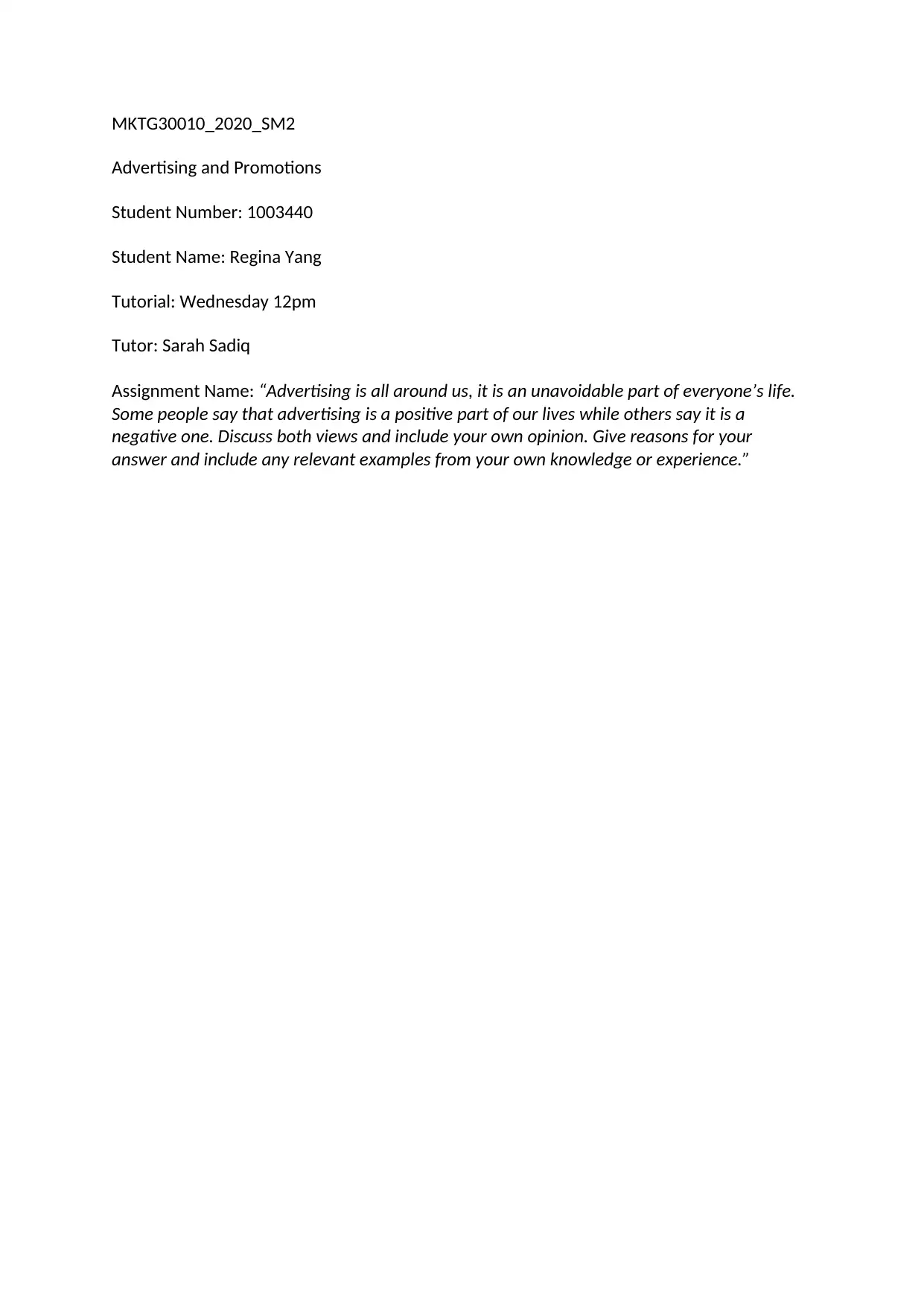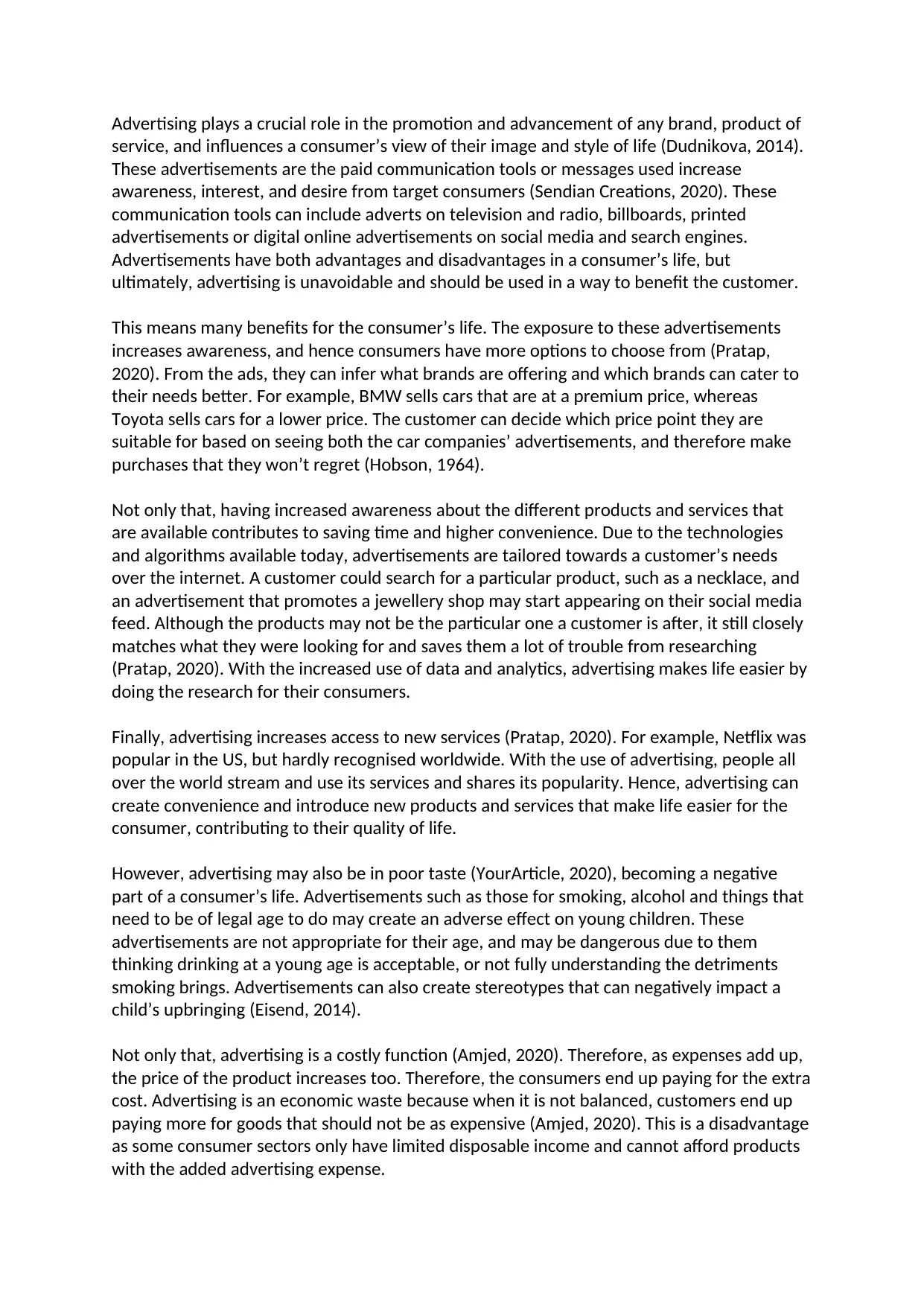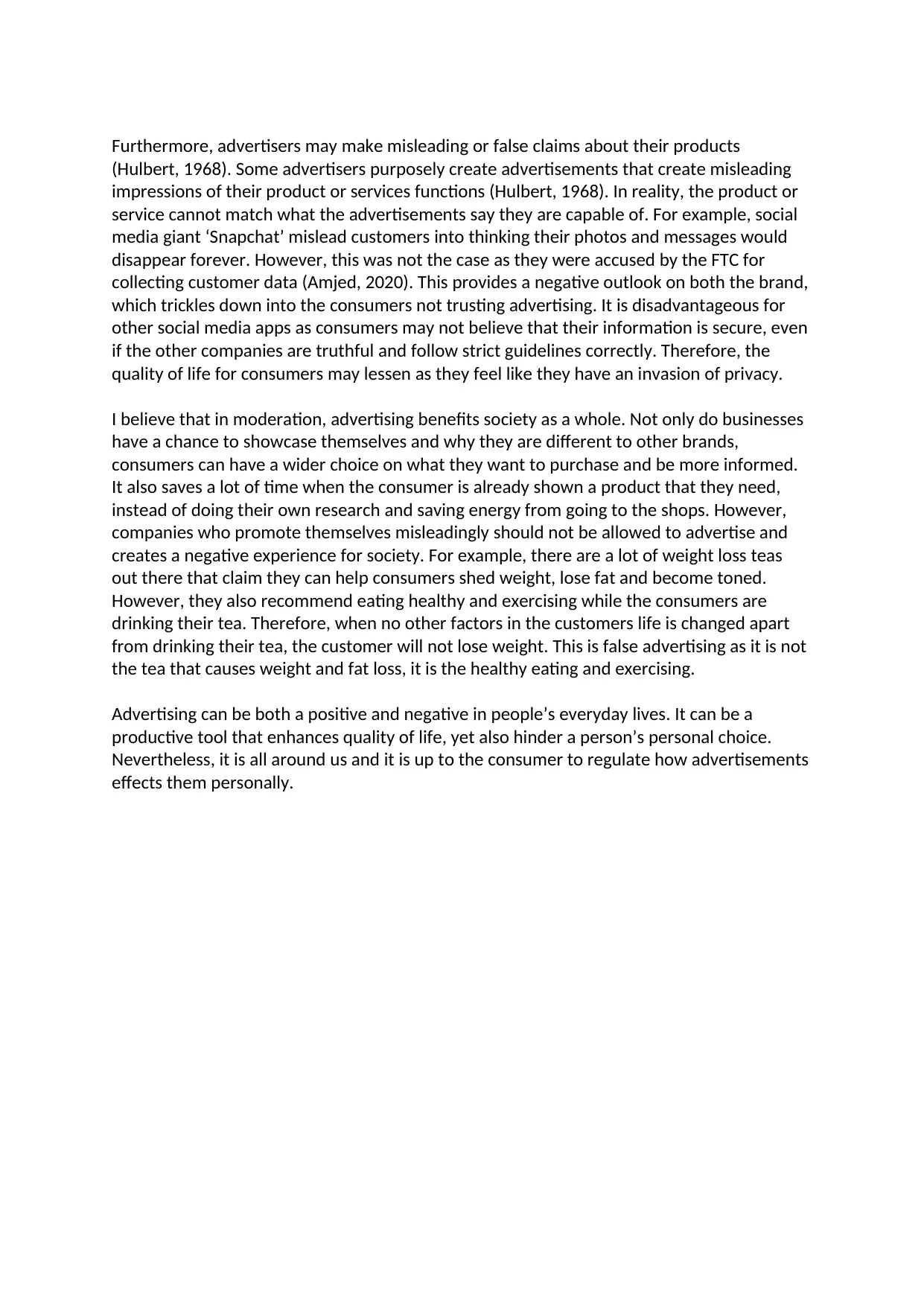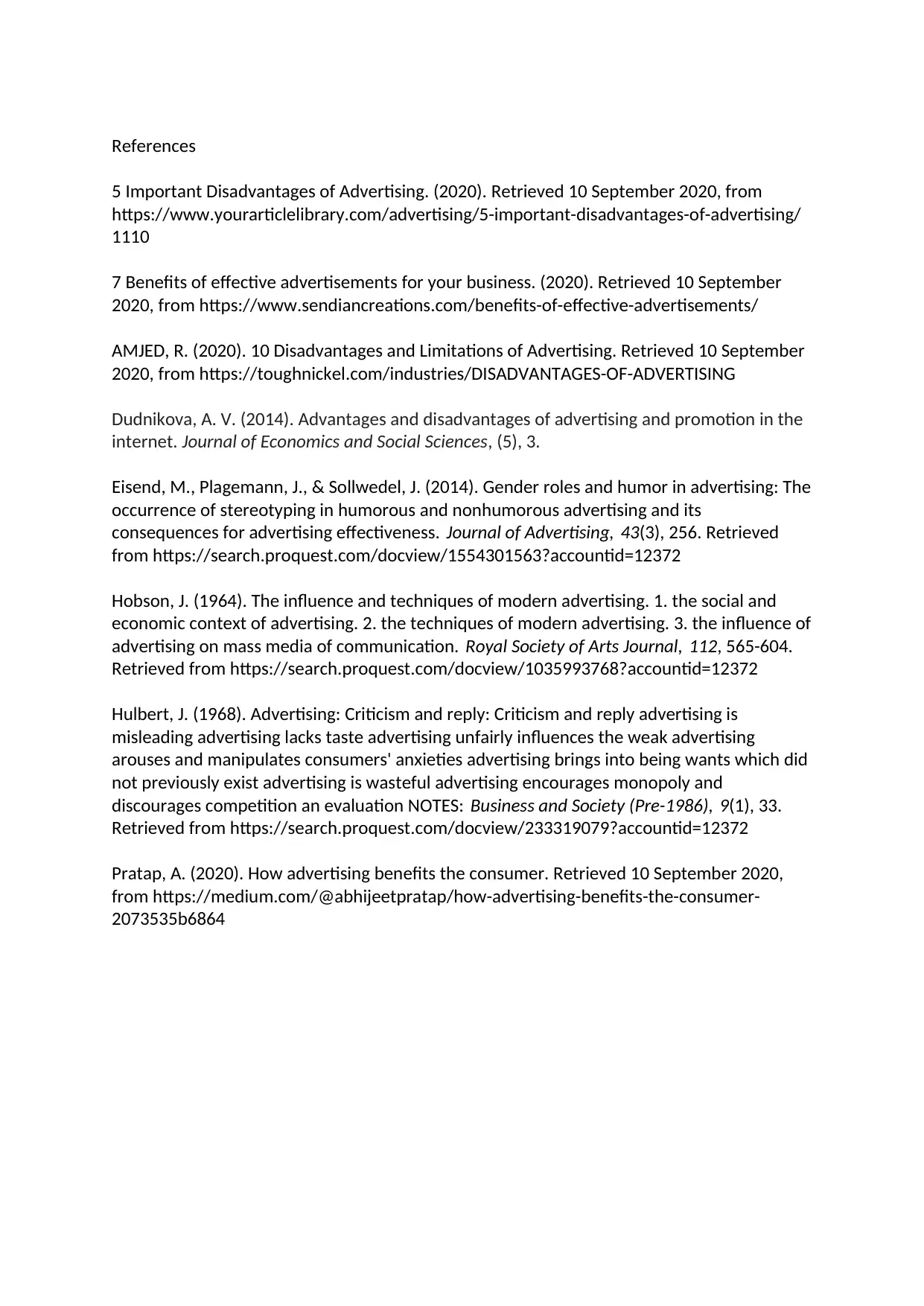Advertising: Discussing Positive and Negative Aspects in Society
VerifiedAdded on 2020/11/10
|4
|1496
|348
Essay
AI Summary
This essay delves into the multifaceted impact of advertising, acknowledging its pervasive presence in modern life. It explores both the advantages and disadvantages of advertising, emphasizing its role in increasing consumer awareness, providing a wider range of choices, and introducing new services. The essay also critically examines the potential negative consequences, such as the promotion of inappropriate content, the economic burden on consumers, and the risk of misleading claims. The author presents a balanced perspective, advocating for the benefits of advertising while acknowledging the need for responsible practices to mitigate its negative impacts. It concludes that advertising, when used ethically, can enhance consumer lives by providing information and choice, but misleading practices should be avoided. The essay includes relevant examples and references to support its arguments, making it a comprehensive analysis of advertising's role in society.

MKTG30010_2020_SM2
Advertising and Promotions
Student Number: 1003440
Student Name: Regina Yang
Tutorial: Wednesday 12pm
Tutor: Sarah Sadiq
Assignment Name: “Advertising is all around us, it is an unavoidable part of everyone’s life.
Some people say that advertising is a positive part of our lives while others say it is a
negative one. Discuss both views and include your own opinion. Give reasons for your
answer and include any relevant examples from your own knowledge or experience.”
Advertising and Promotions
Student Number: 1003440
Student Name: Regina Yang
Tutorial: Wednesday 12pm
Tutor: Sarah Sadiq
Assignment Name: “Advertising is all around us, it is an unavoidable part of everyone’s life.
Some people say that advertising is a positive part of our lives while others say it is a
negative one. Discuss both views and include your own opinion. Give reasons for your
answer and include any relevant examples from your own knowledge or experience.”
Paraphrase This Document
Need a fresh take? Get an instant paraphrase of this document with our AI Paraphraser

Advertising plays a crucial role in the promotion and advancement of any brand, product of
service, and influences a consumer’s view of their image and style of life (Dudnikova, 2014).
These advertisements are the paid communication tools or messages used increase
awareness, interest, and desire from target consumers (Sendian Creations, 2020). These
communication tools can include adverts on television and radio, billboards, printed
advertisements or digital online advertisements on social media and search engines.
Advertisements have both advantages and disadvantages in a consumer’s life, but
ultimately, advertising is unavoidable and should be used in a way to benefit the customer.
This means many benefits for the consumer’s life. The exposure to these advertisements
increases awareness, and hence consumers have more options to choose from (Pratap,
2020). From the ads, they can infer what brands are offering and which brands can cater to
their needs better. For example, BMW sells cars that are at a premium price, whereas
Toyota sells cars for a lower price. The customer can decide which price point they are
suitable for based on seeing both the car companies’ advertisements, and therefore make
purchases that they won’t regret (Hobson, 1964).
Not only that, having increased awareness about the different products and services that
are available contributes to saving time and higher convenience. Due to the technologies
and algorithms available today, advertisements are tailored towards a customer’s needs
over the internet. A customer could search for a particular product, such as a necklace, and
an advertisement that promotes a jewellery shop may start appearing on their social media
feed. Although the products may not be the particular one a customer is after, it still closely
matches what they were looking for and saves them a lot of trouble from researching
(Pratap, 2020). With the increased use of data and analytics, advertising makes life easier by
doing the research for their consumers.
Finally, advertising increases access to new services (Pratap, 2020). For example, Netflix was
popular in the US, but hardly recognised worldwide. With the use of advertising, people all
over the world stream and use its services and shares its popularity. Hence, advertising can
create convenience and introduce new products and services that make life easier for the
consumer, contributing to their quality of life.
However, advertising may also be in poor taste (YourArticle, 2020), becoming a negative
part of a consumer’s life. Advertisements such as those for smoking, alcohol and things that
need to be of legal age to do may create an adverse effect on young children. These
advertisements are not appropriate for their age, and may be dangerous due to them
thinking drinking at a young age is acceptable, or not fully understanding the detriments
smoking brings. Advertisements can also create stereotypes that can negatively impact a
child’s upbringing (Eisend, 2014).
Not only that, advertising is a costly function (Amjed, 2020). Therefore, as expenses add up,
the price of the product increases too. Therefore, the consumers end up paying for the extra
cost. Advertising is an economic waste because when it is not balanced, customers end up
paying more for goods that should not be as expensive (Amjed, 2020). This is a disadvantage
as some consumer sectors only have limited disposable income and cannot afford products
with the added advertising expense.
service, and influences a consumer’s view of their image and style of life (Dudnikova, 2014).
These advertisements are the paid communication tools or messages used increase
awareness, interest, and desire from target consumers (Sendian Creations, 2020). These
communication tools can include adverts on television and radio, billboards, printed
advertisements or digital online advertisements on social media and search engines.
Advertisements have both advantages and disadvantages in a consumer’s life, but
ultimately, advertising is unavoidable and should be used in a way to benefit the customer.
This means many benefits for the consumer’s life. The exposure to these advertisements
increases awareness, and hence consumers have more options to choose from (Pratap,
2020). From the ads, they can infer what brands are offering and which brands can cater to
their needs better. For example, BMW sells cars that are at a premium price, whereas
Toyota sells cars for a lower price. The customer can decide which price point they are
suitable for based on seeing both the car companies’ advertisements, and therefore make
purchases that they won’t regret (Hobson, 1964).
Not only that, having increased awareness about the different products and services that
are available contributes to saving time and higher convenience. Due to the technologies
and algorithms available today, advertisements are tailored towards a customer’s needs
over the internet. A customer could search for a particular product, such as a necklace, and
an advertisement that promotes a jewellery shop may start appearing on their social media
feed. Although the products may not be the particular one a customer is after, it still closely
matches what they were looking for and saves them a lot of trouble from researching
(Pratap, 2020). With the increased use of data and analytics, advertising makes life easier by
doing the research for their consumers.
Finally, advertising increases access to new services (Pratap, 2020). For example, Netflix was
popular in the US, but hardly recognised worldwide. With the use of advertising, people all
over the world stream and use its services and shares its popularity. Hence, advertising can
create convenience and introduce new products and services that make life easier for the
consumer, contributing to their quality of life.
However, advertising may also be in poor taste (YourArticle, 2020), becoming a negative
part of a consumer’s life. Advertisements such as those for smoking, alcohol and things that
need to be of legal age to do may create an adverse effect on young children. These
advertisements are not appropriate for their age, and may be dangerous due to them
thinking drinking at a young age is acceptable, or not fully understanding the detriments
smoking brings. Advertisements can also create stereotypes that can negatively impact a
child’s upbringing (Eisend, 2014).
Not only that, advertising is a costly function (Amjed, 2020). Therefore, as expenses add up,
the price of the product increases too. Therefore, the consumers end up paying for the extra
cost. Advertising is an economic waste because when it is not balanced, customers end up
paying more for goods that should not be as expensive (Amjed, 2020). This is a disadvantage
as some consumer sectors only have limited disposable income and cannot afford products
with the added advertising expense.

Furthermore, advertisers may make misleading or false claims about their products
(Hulbert, 1968). Some advertisers purposely create advertisements that create misleading
impressions of their product or services functions (Hulbert, 1968). In reality, the product or
service cannot match what the advertisements say they are capable of. For example, social
media giant ‘Snapchat’ mislead customers into thinking their photos and messages would
disappear forever. However, this was not the case as they were accused by the FTC for
collecting customer data (Amjed, 2020). This provides a negative outlook on both the brand,
which trickles down into the consumers not trusting advertising. It is disadvantageous for
other social media apps as consumers may not believe that their information is secure, even
if the other companies are truthful and follow strict guidelines correctly. Therefore, the
quality of life for consumers may lessen as they feel like they have an invasion of privacy.
I believe that in moderation, advertising benefits society as a whole. Not only do businesses
have a chance to showcase themselves and why they are different to other brands,
consumers can have a wider choice on what they want to purchase and be more informed.
It also saves a lot of time when the consumer is already shown a product that they need,
instead of doing their own research and saving energy from going to the shops. However,
companies who promote themselves misleadingly should not be allowed to advertise and
creates a negative experience for society. For example, there are a lot of weight loss teas
out there that claim they can help consumers shed weight, lose fat and become toned.
However, they also recommend eating healthy and exercising while the consumers are
drinking their tea. Therefore, when no other factors in the customers life is changed apart
from drinking their tea, the customer will not lose weight. This is false advertising as it is not
the tea that causes weight and fat loss, it is the healthy eating and exercising.
Advertising can be both a positive and negative in people’s everyday lives. It can be a
productive tool that enhances quality of life, yet also hinder a person’s personal choice.
Nevertheless, it is all around us and it is up to the consumer to regulate how advertisements
effects them personally.
(Hulbert, 1968). Some advertisers purposely create advertisements that create misleading
impressions of their product or services functions (Hulbert, 1968). In reality, the product or
service cannot match what the advertisements say they are capable of. For example, social
media giant ‘Snapchat’ mislead customers into thinking their photos and messages would
disappear forever. However, this was not the case as they were accused by the FTC for
collecting customer data (Amjed, 2020). This provides a negative outlook on both the brand,
which trickles down into the consumers not trusting advertising. It is disadvantageous for
other social media apps as consumers may not believe that their information is secure, even
if the other companies are truthful and follow strict guidelines correctly. Therefore, the
quality of life for consumers may lessen as they feel like they have an invasion of privacy.
I believe that in moderation, advertising benefits society as a whole. Not only do businesses
have a chance to showcase themselves and why they are different to other brands,
consumers can have a wider choice on what they want to purchase and be more informed.
It also saves a lot of time when the consumer is already shown a product that they need,
instead of doing their own research and saving energy from going to the shops. However,
companies who promote themselves misleadingly should not be allowed to advertise and
creates a negative experience for society. For example, there are a lot of weight loss teas
out there that claim they can help consumers shed weight, lose fat and become toned.
However, they also recommend eating healthy and exercising while the consumers are
drinking their tea. Therefore, when no other factors in the customers life is changed apart
from drinking their tea, the customer will not lose weight. This is false advertising as it is not
the tea that causes weight and fat loss, it is the healthy eating and exercising.
Advertising can be both a positive and negative in people’s everyday lives. It can be a
productive tool that enhances quality of life, yet also hinder a person’s personal choice.
Nevertheless, it is all around us and it is up to the consumer to regulate how advertisements
effects them personally.
⊘ This is a preview!⊘
Do you want full access?
Subscribe today to unlock all pages.

Trusted by 1+ million students worldwide

References
5 Important Disadvantages of Advertising. (2020). Retrieved 10 September 2020, from
https://www.yourarticlelibrary.com/advertising/5-important-disadvantages-of-advertising/
1110
7 Benefits of effective advertisements for your business. (2020). Retrieved 10 September
2020, from https://www.sendiancreations.com/benefits-of-effective-advertisements/
AMJED, R. (2020). 10 Disadvantages and Limitations of Advertising. Retrieved 10 September
2020, from https://toughnickel.com/industries/DISADVANTAGES-OF-ADVERTISING
Dudnikova, A. V. (2014). Advantages and disadvantages of advertising and promotion in the
internet. Journal of Economics and Social Sciences, (5), 3.
Eisend, M., Plagemann, J., & Sollwedel, J. (2014). Gender roles and humor in advertising: The
occurrence of stereotyping in humorous and nonhumorous advertising and its
consequences for advertising effectiveness. Journal of Advertising, 43(3), 256. Retrieved
from https://search.proquest.com/docview/1554301563?accountid=12372
Hobson, J. (1964). The influence and techniques of modern advertising. 1. the social and
economic context of advertising. 2. the techniques of modern advertising. 3. the influence of
advertising on mass media of communication. Royal Society of Arts Journal, 112, 565-604.
Retrieved from https://search.proquest.com/docview/1035993768?accountid=12372
Hulbert, J. (1968). Advertising: Criticism and reply: Criticism and reply advertising is
misleading advertising lacks taste advertising unfairly influences the weak advertising
arouses and manipulates consumers' anxieties advertising brings into being wants which did
not previously exist advertising is wasteful advertising encourages monopoly and
discourages competition an evaluation NOTES: Business and Society (Pre-1986), 9(1), 33.
Retrieved from https://search.proquest.com/docview/233319079?accountid=12372
Pratap, A. (2020). How advertising benefits the consumer. Retrieved 10 September 2020,
from https://medium.com/@abhijeetpratap/how-advertising-benefits-the-consumer-
2073535b6864
5 Important Disadvantages of Advertising. (2020). Retrieved 10 September 2020, from
https://www.yourarticlelibrary.com/advertising/5-important-disadvantages-of-advertising/
1110
7 Benefits of effective advertisements for your business. (2020). Retrieved 10 September
2020, from https://www.sendiancreations.com/benefits-of-effective-advertisements/
AMJED, R. (2020). 10 Disadvantages and Limitations of Advertising. Retrieved 10 September
2020, from https://toughnickel.com/industries/DISADVANTAGES-OF-ADVERTISING
Dudnikova, A. V. (2014). Advantages and disadvantages of advertising and promotion in the
internet. Journal of Economics and Social Sciences, (5), 3.
Eisend, M., Plagemann, J., & Sollwedel, J. (2014). Gender roles and humor in advertising: The
occurrence of stereotyping in humorous and nonhumorous advertising and its
consequences for advertising effectiveness. Journal of Advertising, 43(3), 256. Retrieved
from https://search.proquest.com/docview/1554301563?accountid=12372
Hobson, J. (1964). The influence and techniques of modern advertising. 1. the social and
economic context of advertising. 2. the techniques of modern advertising. 3. the influence of
advertising on mass media of communication. Royal Society of Arts Journal, 112, 565-604.
Retrieved from https://search.proquest.com/docview/1035993768?accountid=12372
Hulbert, J. (1968). Advertising: Criticism and reply: Criticism and reply advertising is
misleading advertising lacks taste advertising unfairly influences the weak advertising
arouses and manipulates consumers' anxieties advertising brings into being wants which did
not previously exist advertising is wasteful advertising encourages monopoly and
discourages competition an evaluation NOTES: Business and Society (Pre-1986), 9(1), 33.
Retrieved from https://search.proquest.com/docview/233319079?accountid=12372
Pratap, A. (2020). How advertising benefits the consumer. Retrieved 10 September 2020,
from https://medium.com/@abhijeetpratap/how-advertising-benefits-the-consumer-
2073535b6864
1 out of 4
Related Documents
Your All-in-One AI-Powered Toolkit for Academic Success.
+13062052269
info@desklib.com
Available 24*7 on WhatsApp / Email
![[object Object]](/_next/static/media/star-bottom.7253800d.svg)
Unlock your academic potential
Copyright © 2020–2025 A2Z Services. All Rights Reserved. Developed and managed by ZUCOL.




